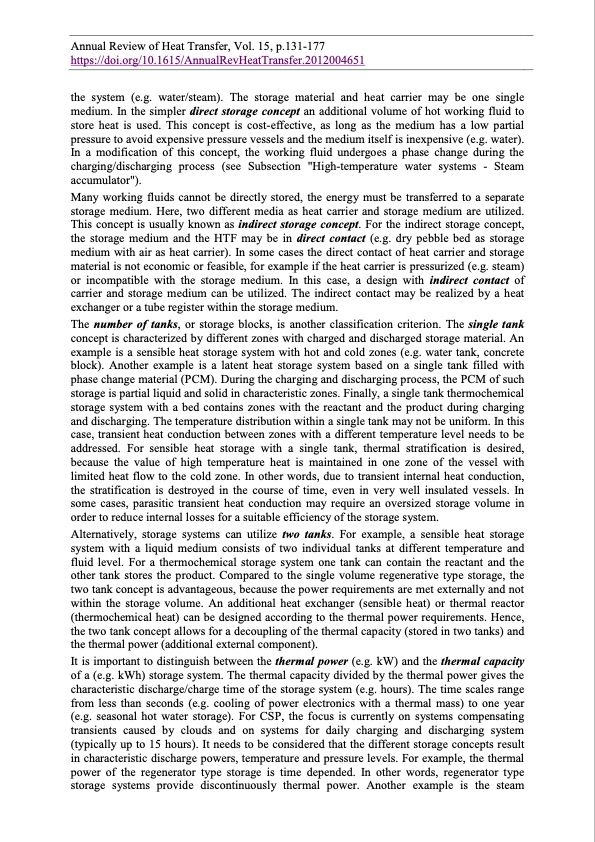
PDF Publication Title:
Text from PDF Page: 005
Annual Review of Heat Transfer, Vol. 15, p.131-177 https://doi.org/10.1615/AnnualRevHeatTransfer.2012004651 the system (e.g. water/steam). The storage material and heat carrier may be one single medium. In the simpler direct storage concept an additional volume of hot working fluid to store heat is used. This concept is cost-effective, as long as the medium has a low partial pressure to avoid expensive pressure vessels and the medium itself is inexpensive (e.g. water). In a modification of this concept, the working fluid undergoes a phase change during the charging/discharging process (see Subsection "High-temperature water systems - Steam accumulator"). Many working fluids cannot be directly stored, the energy must be transferred to a separate storage medium. Here, two different media as heat carrier and storage medium are utilized. This concept is usually known as indirect storage concept. For the indirect storage concept, the storage medium and the HTF may be in direct contact (e.g. dry pebble bed as storage medium with air as heat carrier). In some cases the direct contact of heat carrier and storage material is not economic or feasible, for example if the heat carrier is pressurized (e.g. steam) or incompatible with the storage medium. In this case, a design with indirect contact of carrier and storage medium can be utilized. The indirect contact may be realized by a heat exchanger or a tube register within the storage medium. The number of tanks, or storage blocks, is another classification criterion. The single tank concept is characterized by different zones with charged and discharged storage material. An example is a sensible heat storage system with hot and cold zones (e.g. water tank, concrete block). Another example is a latent heat storage system based on a single tank filled with phase change material (PCM). During the charging and discharging process, the PCM of such storage is partial liquid and solid in characteristic zones. Finally, a single tank thermochemical storage system with a bed contains zones with the reactant and the product during charging and discharging. The temperature distribution within a single tank may not be uniform. In this case, transient heat conduction between zones with a different temperature level needs to be addressed. For sensible heat storage with a single tank, thermal stratification is desired, because the value of high temperature heat is maintained in one zone of the vessel with limited heat flow to the cold zone. In other words, due to transient internal heat conduction, the stratification is destroyed in the course of time, even in very well insulated vessels. In some cases, parasitic transient heat conduction may require an oversized storage volume in order to reduce internal losses for a suitable efficiency of the storage system. Alternatively, storage systems can utilize two tanks. For example, a sensible heat storage system with a liquid medium consists of two individual tanks at different temperature and fluid level. For a thermochemical storage system one tank can contain the reactant and the other tank stores the product. Compared to the single volume regenerative type storage, the two tank concept is advantageous, because the power requirements are met externally and not within the storage volume. An additional heat exchanger (sensible heat) or thermal reactor (thermochemical heat) can be designed according to the thermal power requirements. Hence, the two tank concept allows for a decoupling of the thermal capacity (stored in two tanks) and the thermal power (additional external component). It is important to distinguish between the thermal power (e.g. kW) and the thermal capacity of a (e.g. kWh) storage system. The thermal capacity divided by the thermal power gives the characteristic discharge/charge time of the storage system (e.g. hours). The time scales range from less than seconds (e.g. cooling of power electronics with a thermal mass) to one year (e.g. seasonal hot water storage). For CSP, the focus is currently on systems compensating transients caused by clouds and on systems for daily charging and discharging system (typically up to 15 hours). It needs to be considered that the different storage concepts result in characteristic discharge powers, temperature and pressure levels. For example, the thermal power of the regenerator type storage is time depended. In other words, regenerator type storage systems provide discontinuously thermal power. Another example is the steamPDF Image | Annual Review of Heat Transfer

PDF Search Title:
Annual Review of Heat TransferOriginal File Name Searched:
2012_Thermal_Energy_Storage_Materials_and_Systems.pdfDIY PDF Search: Google It | Yahoo | Bing
Turbine and System Plans CAD CAM: Special for this month, any plans are $10,000 for complete Cad/Cam blueprints. License is for one build. Try before you buy a production license. More Info
Waste Heat Power Technology: Organic Rankine Cycle uses waste heat to make electricity, shaft horsepower and cooling. More Info
All Turbine and System Products: Infinity Turbine ORD systems, turbine generator sets, build plans and more to use your waste heat from 30C to 100C. More Info
CO2 Phase Change Demonstrator: CO2 goes supercritical at 30 C. This is a experimental platform which you can use to demonstrate phase change with low heat. Includes integration area for small CO2 turbine, static generator, and more. This can also be used for a GTL Gas to Liquids experimental platform. More Info
Introducing the Infinity Turbine Products Infinity Turbine develops and builds systems for making power from waste heat. It also is working on innovative strategies for storing, making, and deploying energy. More Info
Need Strategy? Use our Consulting and analyst services Infinity Turbine LLC is pleased to announce its consulting and analyst services. We have worked in the renewable energy industry as a researcher, developing sales and markets, along with may inventions and innovations. More Info
Made in USA with Global Energy Millennial Web Engine These pages were made with the Global Energy Web PDF Engine using Filemaker (Claris) software.
Sand Battery Sand and Paraffin for TES Thermo Energy Storage More Info
| CONTACT TEL: 608-238-6001 Email: greg@infinityturbine.com | RSS | AMP |